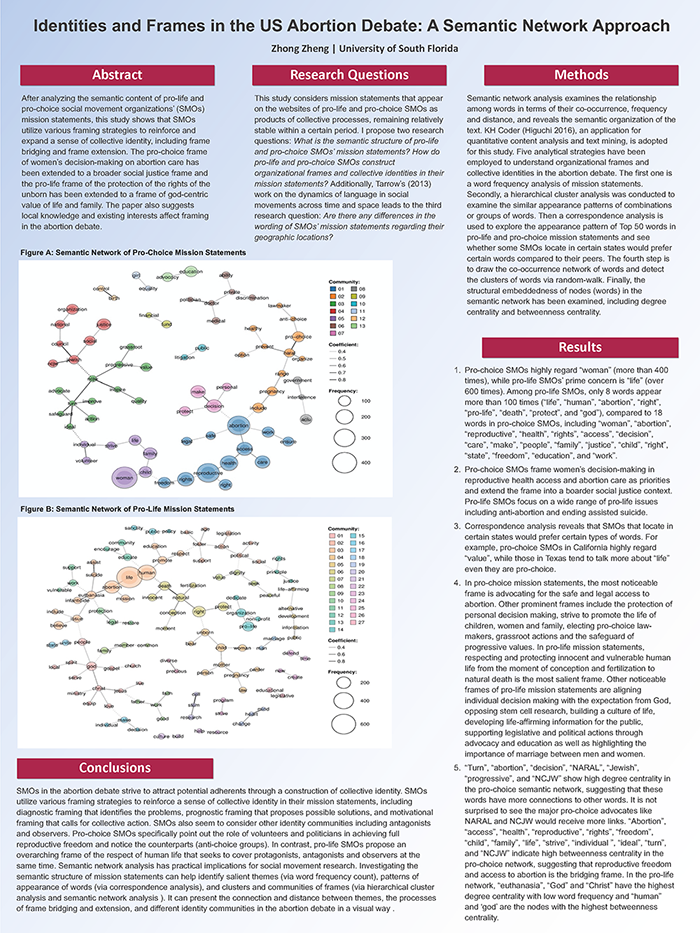
Identities and Frames in the US Abortion Debate: A Semantic Network Approach
Zhong Zheng
Introduction:
This study utilizes semantic network analysis to understand organizational frames and identity communities in the US abortion debate. Semantic network analysis examines the relationship among words with regards to their co-occurrence, frequency and distance.
Research Questions:
What is the semantic structure of pro-life and pro-choice social movement organizations (SMO)’ mission statements? How do pro-life and pro-choice SMOs construct organizational frames and collective identities in their mission statements? Are there any differences in the wording of SMOs’ mission statements with regard to their geographic locations?
Data:
"Pro-life" (anti-abortion) and "pro-choice" (pro-abortion) SMOs are selected based on the search results from GuideStar.
Methods:
KH Coder, an application for quantitative content analysis and text mining, is adopted for cleaning raw data, extracting and counting words, as well as analyzing word concurrences and drawing co-occurrence network of words in this study. Five analytical strategies have been employed, including a word frequency analysis, a hierarchical cluster analysis, a correspondence analysis examining whether some SMOs locate in certain states would prefer certain words compared to their peers, a semantic network displaying clusters of words, and an examination of the structural embeddedness of nodes (words) in the network (degree centrality and betweenness centrality).
Findings:
It seems pro-life SMOs’ prime concern is "life" (more than 1200 times), while pro-choice SMOs highly regard "woma[e]n" (over 800 times). Both utilize various framing strategies to reinforce a sense of collective identity in their mission statements, including diagnostic framing that identifies the problems, prognostic framing that proposes possible solutions, and motivational framing that calls for collective action. The pro-choice frame of women’s decision-making in and access to abortion care has been extended to a broader social justice frame and is connected to the frame of the freedom of speech and the frame of gender equality. In comparison, the pro-life frame of the protection of the rights of the unborn has been extended to a general frame of religious views on human life and is connected to the frame of anti-euthanasia, the frame of the value and definition of marriage and family, and the frame of anti-stem cell research. What’s more, pro-choice SMOs in California highly regard “value”, while those in Texas tend to talk more about “life” even they are pro-choice. This tendency suggests that the construction of organizational frames and collective identities is a combination of local knowledge and culture, pre-existing collective interests as well as negotiations among movement members.
Implications:
Investigating the semantic structure of words can help identify salient themes (via word frequency count), patterns of appearance of words (via correspondence analysis), and clusters and communities of frames (via hierarchical cluster analysis and semantic network analysis). Semantic network analysis can present the connection and distance between frames, the processes of frame bridging and extension, and different identity communities in a visual way. 
← Schedule

